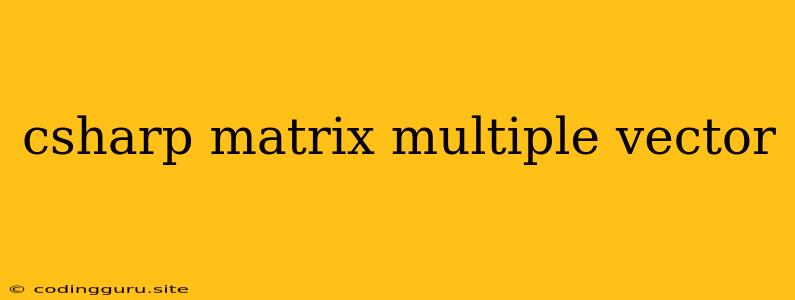Working with Matrices and Vectors in C#
C# provides a powerful and flexible framework for working with linear algebra concepts, including matrices and vectors. This article will explore various ways to manipulate and perform operations on matrices and vectors using C#.
Understanding Matrices and Vectors
Before diving into code examples, let's clarify what matrices and vectors represent:
- Matrix: A matrix is a rectangular array of numbers arranged in rows and columns. It can be visualized as a table with rows representing the number of equations and columns representing the number of variables.
- Vector: A vector is a one-dimensional array of numbers representing a direction and magnitude in space. In the context of matrices, a vector can be considered a matrix with a single column.
Representing Matrices and Vectors in C#
C# offers several ways to represent matrices and vectors:
- Arrays: You can use multidimensional arrays to represent matrices and one-dimensional arrays for vectors. This approach provides flexibility but requires manual handling of indexing and operations.
- Custom Classes: Creating custom classes to represent matrices and vectors allows you to encapsulate data and operations. You can define methods for matrix multiplication, addition, transpose, and other common operations.
- Third-party Libraries: Libraries like MathNet.Numerics, Accord.NET, and Eigen offer sophisticated functionalities for working with matrices and vectors, including advanced algorithms and optimized performance.
Matrix-Vector Multiplication in C#
One fundamental operation involving matrices and vectors is matrix-vector multiplication. This process results in a new vector obtained by combining the rows of the matrix with the elements of the vector. Here's a simple example using a custom class:
public class Matrix
{
public double[,] Data;
public Matrix(int rows, int cols)
{
Data = new double[rows, cols];
}
public Vector Multiply(Vector vector)
{
if (Data.GetLength(1) != vector.Data.Length)
{
throw new ArgumentException("Matrix columns must match vector size.");
}
Vector result = new Vector(Data.GetLength(0));
for (int i = 0; i < Data.GetLength(0); i++)
{
for (int j = 0; j < Data.GetLength(1); j++)
{
result.Data[i] += Data[i, j] * vector.Data[j];
}
}
return result;
}
}
public class Vector
{
public double[] Data;
public Vector(int size)
{
Data = new double[size];
}
}
// Example usage
Matrix matrix = new Matrix(2, 3);
matrix.Data = new double[,] { { 1, 2, 3 }, { 4, 5, 6 } };
Vector vector = new Vector(3);
vector.Data = new double[] { 7, 8, 9 };
Vector result = matrix.Multiply(vector);
Console.WriteLine("Resultant Vector:");
foreach (double element in result.Data)
{
Console.WriteLine(element);
}
This code defines Matrix and Vector classes with basic operations. The Multiply method within the Matrix class calculates the product of a matrix and a vector.
Matrix-Vector Multiplication with Third-party Libraries
Using libraries like MathNet.Numerics simplifies matrix-vector multiplication significantly. Here's an example using MathNet.Numerics:
using MathNet.Numerics.LinearAlgebra;
// Create a matrix and a vector
Matrix matrix = Matrix.Build.DenseOfArray(new double[,] { { 1, 2, 3 }, { 4, 5, 6 } });
Vector vector = Vector.Build.DenseOfArray(new double[] { 7, 8, 9 });
// Perform matrix-vector multiplication
Vector result = matrix * vector;
// Print the result
Console.WriteLine("Resultant Vector:");
Console.WriteLine(result);
MathNet.Numerics provides convenient methods for creating and manipulating matrices and vectors. The * operator performs matrix-vector multiplication directly.
Tips for Working with Matrices and Vectors in C#
- Utilize Libraries: Employ libraries like MathNet.Numerics for advanced functionalities and optimized performance.
- Choose Appropriate Data Structures: Select appropriate data structures based on your needs. Arrays are versatile but require manual handling, while custom classes provide encapsulation and abstraction.
- Understand Matrix Dimensions: Ensure that matrix dimensions match vector sizes during operations like multiplication.
Conclusion
C# offers various tools and approaches for working with matrices and vectors. Understanding the concepts of matrices, vectors, and their operations is crucial for tackling various mathematical and engineering problems. Choosing the right representation and tools for your specific scenario is essential to achieve clarity and efficiency.
